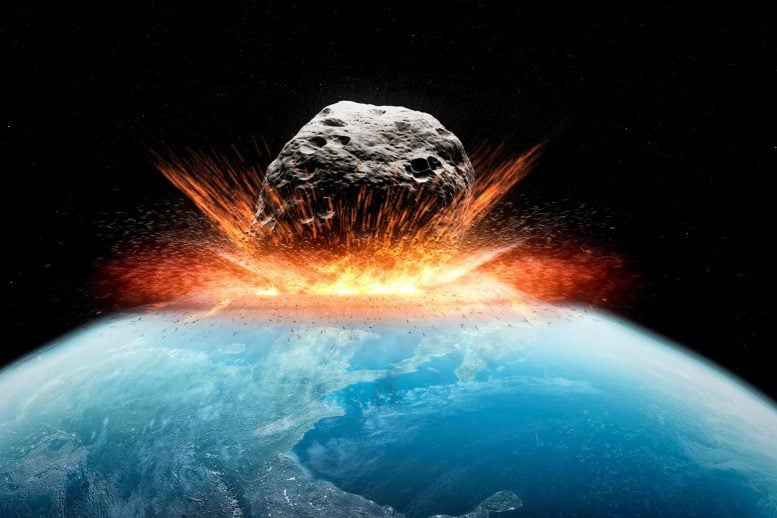
International research team investigated the isotopic composition of rocky planets in the inner Solar System.
Earth and Mars were formed from material that largely originated in the inner Solar System; only a few percent of the building blocks of these two planets originated beyond Jupiter’s orbit. A group of researchers led by the University of Münster (Germany) report these findings on December 22, 2021, in the journal Science Advances. They present the most comprehensive comparison to date of the isotopic composition of Earth, Mars, and pristine building material from the inner and outer Solar System. Some of this material is today still found largely unaltered in meteorites. The results of the study have far-reaching consequences for our understanding of the process that formed the planets Mercury, Venus, Earth, and Mars. The theory postulating that the four rocky planets grew to their present size by accumulating millimeter-sized dust pebbles from the outer Solar System is not tenable.
Approximately 4.6 billion years ago in the early days of our Solar System, a disk of dust and gases orbited the young Sun. Two theories describe how in the course of millions of years the inner rocky planets formed from this original building material. According to the older theory, the dust in the inner Solar System agglomerated to ever larger chunks gradually reaching approximately the size of our Moon. Collisions of these planetary embryos finally produced the inner planets Mercury, Venus, Earth, and Mars. A newer theory, however, prefers a different growth process: millimeter-sized dust “pebbles” migrated from the outer Solar System towards the Sun. On their way, they were accreted onto the planetary embryos of the inner Solar System, and step by step enlarged them to their present size.
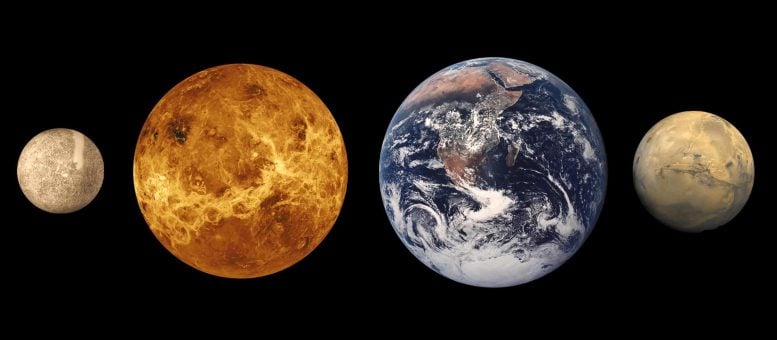
The four terrestrial planets: Mercury, Venus, Earth and Mars. Credit: NASA/Lunar and Planetary Institute
Both theories are based on theoretical models and computer simulations aimed at reconstructing the conditions and dynamics in the early Solar System; both describe a possible path of planet formation. But which one is right? Which process actually took place? To answer these questions, in their current study researchers from the University of Münster (Germany), the Observatoire de la Cote d’Azur (France), the California Institute of Technology (USA), the Natural History Museum Berlin (Germany), and the Free University of Berlin (Germany) determined the exact composition of the rocky planets Earth and Mars.
“We wanted to find out whether the building blocks of Earth and Mars originated in the outer or inner Solar System,” says Dr. Christoph Burkhardt of the University of Münster, the study’s first author. To this end, the isotopes of the rare metals titanium, zirconium, and molybdenum found in minute traces in the outer, silicate-rich layers of both planets provide crucial clues. Isotopes are different varieties of the same element, which differ only in the weight of their atomic nucleus.
Meteorites as a reference
Scientists assume that in the early Solar System these and other metal isotopes were not evenly distributed. Rather, their abundance depended on the distance from the Sun. They therefore hold valuable information about where in the early Solar System a certain body’s building blocks originated.
As a reference for the original isotopic inventory of the outer and inner Solar System, the researchers used two types of meteorites. These chunks of rock generally found their way to Earth from the asteroid belt, the region between the orbits of Mars and Jupiter. They are considered to be largely pristine material from the beginnings of the Solar System. While so-called carbonaceous chondrites, which can contain up to a few percent carbon, originated beyond Jupiter’s orbit and only later relocated to the asteroid belt due to influence of the growing gas giants, their more carbon-depleted cousins, the non-carbonaceous chondrites, are true children of the inner Solar System.
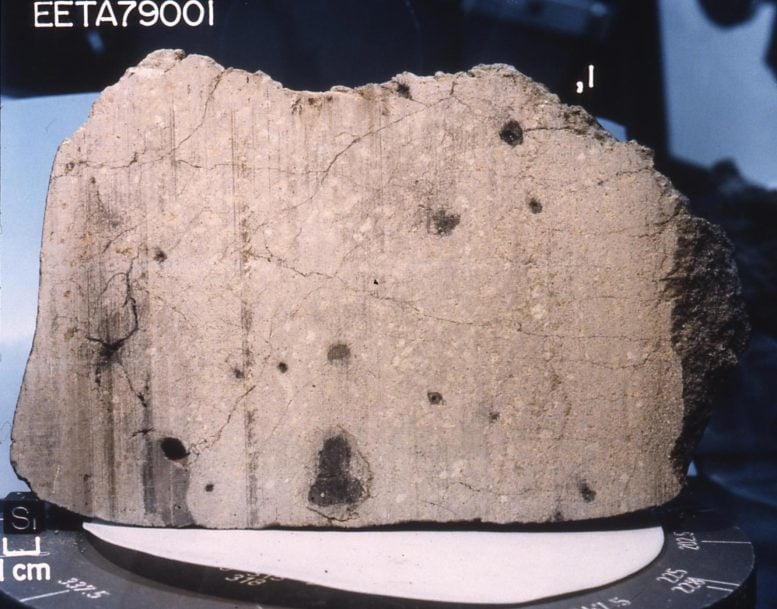
The Martian Meteorite Elephant Moraine (EETA) 79001. The scientists examined these and other Martian meteorites in the study. Credit NASA/JSC
The precise isotopic composition of Earth’s accessible outer rock layers and that of both types of meteorites have been studied for some time; however, there have been no comparably comprehensive analyses of Martian rocks. In their current study, the researchers now examined samples from a total of 17 Martian meteorites, which can be assigned to six typical types of Martian rock. In addition, the scientists for the first time investigated the abundances of three different metal isotopes.
The samples of Martian meteorites were first powdered and subjected to complex chemical pretreatment. Using a multicollector plasma mass spectrometer at the Institute of Planetology at the University of Münster, the researchers were then able to detect tiny amounts of titanium, zirconium, and molybdenum isotopes. They then performed computer simulations to calculate the ratio in which building material found today in carbonaceous and non-carbonaceous chondrites must have been incorporated into Earth and Mars in order to reproduce their measured compositions. In doing so, they considered two different phases of accretion to account for the different history of the titanium and zirconium isotopes as well as of the molybdenum isotopes, respectively. Unlike titanium and zirconium, molybdenum accumulates mainly in the metallic planetary core. The tiny amounts still found today in the silicate-rich outer layers can therefore only have been added during the very last phase of the planet’s growth.
The researchers’ results show that the outer rock layers of Earth and Mars have little in common with the carbonaceous chondrites of the outer Solar System. They account for only about four percent of both planets’ original building blocks. “If early Earth and Mars had mainly accreted dust grains from the outer Solar System, this value should be almost ten times higher,” says Prof. Dr. Thorsten Kleine of the University of Münster, who is also director at the Max Planck Institute for Solar System Research in Göttingen. “We thus cannot confirm this theory of the formation of the inner planets,” he adds.
Lost building material
But the composition of Earth and Mars does not exactly match the material of the non-carbonaceous chondrites either. The computer simulations suggest that another, different kind of building material must also have been in play. “The isotopic composition of this third type of building material as inferred by our computer simulations implies it must have originated in the innermost region of the Solar System,” explains Christoph Burkhardt. Since bodies from such close proximity to the Sun were almost never scattered into the asteroid belt, this material was almost completely absorbed into the inner planets and thus does not occur in meteorites. “It is, so to speak, ‘lost building material’ to which we no longer have direct access today,” says Thorsten Kleine.
The surprising find does not change the consequences of the study for theory of planet formation. “The fact that Earth and Mars apparently contain mainly material from the inner Solar System fits well with planet formation from the collisions of large bodies in the inner Solar System,” concludes Christoph Burkhardt.
Reference: “Terrestrial planet formation from lost inner solar system material” by Christoph Burkhardt, Fridolin Spitzer, Alessandro Morbidelli, Gerrit Budde, Jan H. Render, Thomas S. Kruijer and Thorsten Kleine, 22 December 2021, Science Advances.
DOI: 10.1126/sciadv.abj7601

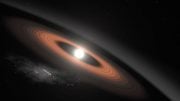
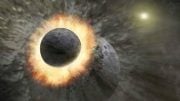
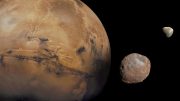


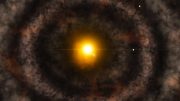
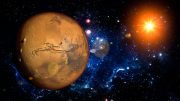
Interesting theory with still no actually evidence. According to scientists we all come from a monkey and life evoluted from nothing over billions of years. The earths magnetic field protects us from the suns radiation discliams this theory. How about – In the beginning God created the heavens and the earth. Been around from the beginning and the discovery of DNA backs it.
How about instead we notice the way the atoms just seem to want to stick together in surprisingly useful ways? Heck of a lot more useful than saying Gowdidit all the time.
Enough nonsense, please. You people think that everyone that listened to you is stupid. After the earth was formed due to collision, water, air, cloud, human and other life came to settle on the earth and the sea out of none existent air and living things universe? Thanks.
And pig came from monkeys
It s amusing that so much happenstance was needed to create the earth we live on today and the recent proposition that *WE* are unique in the entire universe is tauted.
Therefore it seems perfectly logical that it s been created by God!
All not true, God created the earth and all that comes with, there is a book that tells us the whole story, its called a Bible, stop doing more research, its costing you money and time, Thank you so much, may the Lords grace be with you
.
Must be nice to make theories and have people believe you and get paid.
Nobody knows where we came from, when the earth was formed or when will it end. Keep guessing.
All orbits begin their lives as a single mass of what is called quark plasma. This gamma ray emitting plasma is invisible and can make shapes. This plasma is what minimum entropy black holes are made of. The galaxies are shrapnel from the collision of two, maximum entropy objects that contained the mass of the observable galaxies. Our galaxy was spinning as a result and the plasma made a disk with a bulbous center. The center separated from the disk and our black hole was formed. The remaining massive disk was left to create the solar systems. Our solar system was spinning as well and made a disk just like our galaxy. The center separated from the disk and our Sun was born. Finally, again, the planets and their corresponding moons and rings used the exact same process. The inner planets are rocky because they cooled the fastest since they possessed the least energy. Quark plasma converts itself to potential energy by creating neutrons first on the surface. This gives the mass its first light of its life. The neutrons break down into hydrogen atoms and then they are connected to the constantly forming neutrons to create helium using the beta minus decay reaction. Heavier elements are filtering the energy from the quark plasma core more and more. Eventually, the surface goes dark and an atmosphere is able to form. Jupiter is the only planet that hasn’t completely finished its crust yet which is evident giving the massive radiation coming from the equator. The crust started at the poles and migrated to the equator.
This is bs satan trying to discredit god
Maybe God slammed the two objects together. I don’t know.
Obviously this article is just a made up story. Sorry but i dont buy it.
SCIENTISTS WILL NEVER EVER BE NEAR TO DEFINE GODS CREATION.
Están bien locos lo único que sale de una explosión son cosas malas nunca he visto que ha salido algo bueno cuando hay una explosión
More BS
Wonderful speculation, But not solid science. Very typical of astronomy these days.
Now, now! They ruled out an hypothosis. That is what science does.
I’m not sure why my comment was deleted. Our current theories are not panning out. Orbits themselves are so incredibly delicate that they must have been created by a single mass initially. It is just plain scary how science continues to back a theory that has never worked.
Here come the god wackos crawling out of the woodwork to spread their paranoia and incessant need to feel important in the scheme of things.
Why do people think that God created earth? Sorry to say but their is more then one God, and God’s don’t create worlds. They create life in those worlds. Earth was not God’s “creation”. I get that you guys have a religion but their are things that can go beyond God’s power. Maybe he did create life but no…not worlds.:)
Idiots, God created the heavens and the earth and all that is in it. Amen
Two thoughts.
Who made god? Before the beginning?
And why does every christian prayer end with a dedication to an Egyption god, the one that oddball pharoh foisted on everyone, the one that got immediaitly chsed out of Egypt as soon as the phaoroh died? Did you ever think about that? Did you notice that ONLY SOME versions of the bible have Christ doing that. Did you ever think about that? The clear implication is, another god, a squatter, on the run from Egypt, is living in your gods house. Did you ever think about THAT?
Entirely embarrassing. This is bunk. Science is rather humored, as am I. The Heavens declare the glory of God, not the wisdom of man, nor the randomness of nature. The signature of God is clearly seen in the image of every petal of every rose.
Dang, you all are so polarized. Did it ever occur to any of you that both sides are ‘”right”? Maybe God did create everything, but if He is all knowing, wouldn’t he know every law of nature and everything about physics, chemistry, biology, and all other sciences, enough science to be the brain behind the making of the universe? I personally think that God answers the who and why questions and science answers the how. God created all this because he loves us and wants us to be happy and learn, and he created it all using all of the science that we know of today and more that we have yet to discover. So both arguments are right, it’s possible to be religious and believe in science too.
Leisel is the only one out of all of you that has any sense…I believe in people…I know we are all idiots…the only reason we think we are smart is because nobody has said to us…hold my beer!!! Haaa